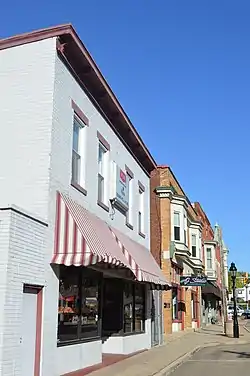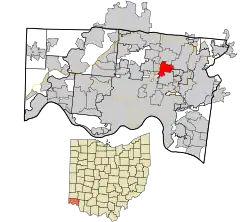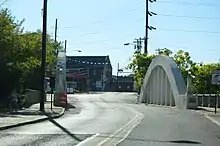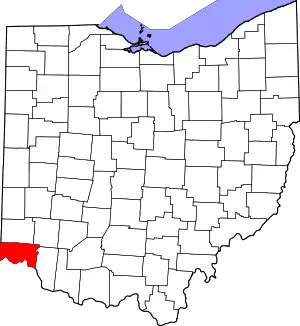Reading, Ohio
Reading (pronounced /ˈrɛdɪŋ/ RED-ing) is a city in Hamilton County, Ohio, United States. The population was 10,385 at the 2010 census.[8] It is an inner suburb of Cincinnati.
Reading, Ohio | |
|---|---|
 Benson Street downtown | |
| Mottoes: | |
 Location in Hamilton County and the state of Ohio. | |
| Coordinates: 39°13′22″N 84°26′21″W | |
| Country | United States |
| State | Ohio |
| County | Hamilton |
| Settled | 1797 |
| Incorporated | March 24, 1851 |
| Became a city | January 1, 1932 |
| Withdrew from Sycamore Township | May 19, 1943 |
| Government | |
| • Mayor | Robert Bemmes (R)[2] |
| Area | |
| • Total | 2.89 sq mi (7.48 km2) |
| • Land | 2.89 sq mi (7.48 km2) |
| • Water | 0.00 sq mi (0.00 km2) |
| Elevation | 561 ft (171 m) |
| Population | |
| • Total | 10,385 |
| • Estimate (2019)[6] | 10,296 |
| • Density | 3,563.86/sq mi (1,375.89/km2) |
| Time zone | UTC-5 (Eastern (EST)) |
| • Summer (DST) | UTC-4 (EDT) |
| ZIP codes | 45215, 45236, 45237 |
| Area code(s) | 513 |
| FIPS code | 39-65732[7] |
| GNIS feature ID | 1056486[4] |
| Website | www |
Geography
Reading is located at 39°13′22″N 84°26′21″W (39.222709, -84.439036).[9] According to the United States Census Bureau, the city has a total area of 2.89 square miles (7.49 km2), all land.[10]
Reading is bordered by Cincinnati's Roselawn neighborhood to the south, Amberley Village and Sycamore Township to the southeast, Blue Ash to the east, Evendale to the north, Lockland to the west, and Arlington Heights to the southwest. Mill Creek divides Reading from Lockland and Arlington Heights.
Reading can be reached by car via Interstate 75, Ohio State Route 126, or U.S. Route 42. The northbound lanes of Mill Creek Expressway run along the city's west side, with exits onto Galbraith Road and Koehler Avenue. Ronald Reagan Cross County Highway has a complex interchange with Interstate 75 at Reading. Reading lies along Norfolk Southern Railway's Dayton District and the Indiana and Ohio Railway's Oasis Subdivision.
History
In 1794, Abraham Voorhees moved his family from Somerset County, New Jersey, building a large double log cabin along the west bank of the Millcreek in Sycamore Township, in present-day Lockland. In the spring of 1795, Harvey Redinbo, a Pennsylvania Dutchman, visited from Reading, Pennsylvania. Pleased with the land that Voorhees had acquired, Redinbo purchased his own land, in the area of Hunt Road and Columbia Avenue. Around 1798, Voorhees platted a town named Voorhees-Town but did not record it with county officials until January 7, 1804. By then, Redinbo had convinced him to rename the town to Reading, after Redinbo's hometown.[11][12][13]
Between 1830 and 1880, Reading grew rapidly to become the largest village in Hamilton County. It was incorporated as a village on March 24, 1851. The village's major industry was clothing manufacturing.[11][13][14]

The Benson Street Bridge, built in 1901, spans Mill Creek on the city limit with Lockland. It was the second concrete rainbow arch bridge and the first in Ohio.[15][16]
Reading became a city on January 1, 1932.[18] It withdrew from Sycamore Township on May 19, 1943, forming a paper township named "Reading Township".[19]
Demographics
| Historical population | |||
|---|---|---|---|
| Census | Pop. | %± | |
| 1860 | 1,230 | — | |
| 1870 | 1,575 | 28.0% | |
| 1880 | 2,680 | 70.2% | |
| 1900 | 3,076 | — | |
| 1910 | 3,985 | 29.6% | |
| 1920 | 4,540 | 13.9% | |
| 1930 | 5,723 | 26.1% | |
| 1940 | 6,079 | 6.2% | |
| 1950 | 7,836 | 28.9% | |
| 1960 | 12,832 | 63.8% | |
| 1970 | 14,617 | 13.9% | |
| 1980 | 12,843 | −12.1% | |
| 1990 | 12,038 | −6.3% | |
| 2000 | 11,292 | −6.2% | |
| 2010 | 10,385 | −8.0% | |
| 2019 (est.) | 10,296 | [6] | −0.9% |
| Sources:[7][20][21] | |||
2010 census
As of the census[5] of 2010, there were 10,385 people, 4,554 households, and 2,624 families residing in the city. The population density was 3,593.4 inhabitants per square mile (1,387.4/km2). There were 4,962 housing units at an average density of 1,717.0 per square mile (662.9/km2). The racial makeup of the city was 89.1% White, 7.3% African American, 0.1% Native American, 1.0% Asian, 0.6% from other races, and 1.9% from two or more races. Hispanic or Latino of any race were 1.7% of the population.
There were 4,554 households, of which 26.8% had children under the age of 18 living with them, 39.0% were married couples living together, 13.3% had a female householder with no husband present, 5.3% had a male householder with no wife present, and 42.4% were non-families. 36.6% of all households were made up of individuals, and 11.1% had someone living alone who was 65 years of age or older. The average household size was 2.26 and the average family size was 2.97.
The median age in the city was 39.5 years. 21.6% of residents were under the age of 18; 8.6% were between the ages of 18 and 24; 27.2% were from 25 to 44; 27.5% were from 45 to 64; and 14.9% were 65 years of age or older. The gender makeup of the city was 49.1% male and 50.9% female.
2000 census
As of the census[7] of 2000, there were 11,292 people, 4,885 households, and 2,921 families residing in the city. The population density was 3,867.6 people per square mile (1,493.1/km2). There were 5,128 housing units at an average density of 1,756.4 per square mile (678.1/km2). The racial makeup of the city was 93.69% White, 3.20% African American, 0.16% Native American, 1.18% Asian, 0.02% Pacific Islander, 0.51% from other races, and 1.25% from two or more races. Hispanic or Latino of any race were 0.79% of the population.
There were 4,885 households, out of which 27.1% had children under the age of 18 living with them, 44.7% were married couples living together, 11.0% had a female householder with no husband present, and 40.2% were non-families. 34.3% of all households were made up of individuals, and 11.8% had someone living alone who was 65 years of age or older. The average household size was 2.27 and the average family size was 2.96.
In the city the population was spread out, with 22.5% under the age of 18, 9.3% from 18 to 24, 31.1% from 25 to 44, 21.1% from 45 to 64, and 16.0% who were 65 years of age or older. The median age was 38 years. For every 100 females, there were 94.8 males. For every 100 females age 18 and over, there were 91.2 males.
The median income for a household in the city was $39,140, and the median income for a family was $51,858. Males had a median income of $35,466 versus $26,250 for females. The per capita income for the city was $23,527. About 4.7% of families and 7.3% of the population were below the poverty line, including 7.8% of those under age 18 and 10.2% of those age 65 or over.
_Clarence_Halker%252C_first_Reading_boy_to_make_supreme_sacrifice_in_World_War_I%22_art_detail%252C_from-_Reading_centennial_souvenir_(page_19_crop).jpg.webp)
Economy
Like other communities in the Mill Creek Valley, Reading has an economy dominated by heavy industry, including suppliers for aerospace and automotive plants in nearby Sharonville and Evendale. Thermo Fisher Scientific's Patheon subsidiary operates a pharmaceutical manufacturing plant on 30 acres (12 ha) in the city.[22]
The Bridal District along Benson Street in downtown Reading is the most well-known concentration of wedding-related businesses in the United States.[23][24]
The electronics store chain Steinberg's was founded and based in Reading until its bankruptcy and liquidation in 1997.
Government
.jpg.webp)
Reading uses a mayor–council form of government. The city council consists of a tie-breaking President of Council, four members representing wards, and three at-large members.[25] As of 2020, the Mayor of Reading is Robert "Bo" Bemmes[26] and the current council president is Cris Nesbitt.[27]
Reading is one of 23 municipalities in Hamilton County that maintains a mayor's court, in which traffic cases and other misdemeanor cases are heard by a magistrate.
At the federal level, Reading is located within Ohio's 2nd congressional district. At the state level, Reading belongs to the 28th House district and 8th Senate district. See Ohio House of Representatives and Ohio Senate for the current representatives of the respective state districts.
Education
The Reading Community City School District, Reading's public school system, includes two neighborhood schools, Central Elementary and Hilltop Elementary, which both serve Pre-K through fifth grade. Reading Middle School is co-located with Central Elementary and houses grades 6–8. Reading High School serves grades 9-12 and is the home of the 2003 division III state boys basketball champions. The new Pre K-12 school opened up Monday September 9, 2019.
Reading includes a Roman Catholic all-girl's high school, Mount Notre Dame High School, where the daughter of Civil War general William Tecumseh Sherman was one of the first students. Also included is a Catholic elementary school, Sts. Peter and Paul Academy serve students in grades K-8.
Reading is served by a branch of the Public Library of Cincinnati and Hamilton County.[28]
Media
Reading is part of the Cincinnati media market for newspapers, radio, and television. WMKV (89.3 FM) broadcasts from a retirement community in Reading.
Notable people
- Ed Biles – professional football coach, Houston Oilers
- John Boehner – Speaker of the U.S. House of Representatives[29]
- Rick Christophel – professional football coach, Tampa Bay Buccaneers
- Ralph Davis – professional basketball player
- Richard E. Meyer – businessman and record producer
- Brian O'Connor – professional baseball pitcher
- Merle Robbins – inventor of the card game Uno[30]
- Joseph G. Wilson – Republican politician in Oregon
- DeShawn Wynn – professional football player
References
- Schaefer, Walt (January 11, 1991). "Encapsuled communities: Mottos sum up ambience of area neighborhoods". The Cincinnati Enquirer (West ed.). pp. 1–2 Extra – via Newspapers.com.
READING: 'Wir Tun Unser Bestes' (We Try Our Best). This slogan, which appears on the city flag, was born in a Cub Scout group project for the nation's bicentennial in 1976, said Harold Davis, president of the Reading Board of Education and former leader of Cub Scout Pack 665. Each of 30 scouts created a flag based on Reading history. 'We did not take any one idea but combined ideas into a single thought,' Davis said. 'The motto (on the flag) reflects the German ancestry of our city.'
- "Hamilton County Officials 2016" (PDF). Hamilton County Board of Elections. 27 January 2016. p. 20. Retrieved 1 February 2016.
- "2019 U.S. Gazetteer Files". United States Census Bureau. Retrieved July 28, 2020.
- "US Board on Geographic Names". United States Geological Survey. 2007-10-25. Retrieved 2008-01-31.
- "U.S. Census website". United States Census Bureau. Retrieved 2013-01-06.
- "Population and Housing Unit Estimates". Retrieved May 21, 2020.
- "U.S. Census website". United States Census Bureau. Retrieved 2008-01-31.
- "Profile of General Population and Housing Characteristics: 2010 Demographic Profile Data (DP-1): Reading city, Ohio". United States Census Bureau. Retrieved October 31, 2012.
- "US Gazetteer files: 2010, 2000, and 1990". United States Census Bureau. 2011-02-12. Retrieved 2011-04-23.
- "US Gazetteer files 2010". United States Census Bureau. Archived from the original on 2012-01-24. Retrieved 2013-01-06.
- Nelson, S. B. (1894). History of Cincinnati and Hamilton County, Ohio: Their Past and Present, Including...biographies and Portraits of Pioneers and Representative Citizens, etc. 1. p. 448. Retrieved December 11, 2013 – via Google Books.
- Gentry-Fletcher, Gina (June 9, 1994). "Reading set to celebrate centennial". The Cincinnati Enquirer (Central ed.). p. 5 Extra – via Newspapers.com.
- Ford, Henry A.; Ford, Kate B., eds. (1881). History of Hamilton County, Ohio, with illustrations and biographical sketches. Cleveland. pp. 390, 393 – via HathiTrust.
- Gertz, Charles (1951). "A history of Reading". Reading centennial souvenir: City of Reading, Ohio, founded 1797, incorporated 1851. Schulte & Cappel. p. 31 – via Public Library of Cincinnati and Hamilton County.
- McNutt, Randy (January 20, 2004). "Benson Street Bridge: A neighborly connection". The Cincinnati Enquirer. p. G8 – via Newspapers.com.
- Eckberg, John (May 12, 1994). "Welcome sign reminded 'friends' not to fight". The Cincinnati Enquirer (Central ed.). p. 2 Extra – via Newspapers.com.
- "Population, 1870-1850, in each State and Territory, by Civil Divisions less than Counties, as White and Colored, and Native and Foreign" (PDF). 1870 Census. 1. United States Census Bureau. p. 232.
"Native and Foreign Born and White and White and Colored Population, Classified by Sex, for Places Having 2,500 Inhabitants or More: 1900" (PDF). Twelfth Census of the United States Taken in the Year 1900. 1. United States Census Bureau. p. 674.
"Census of Population and Housing, 1910: Population—Ohio" (PDF). Thirteenth Census of the United States. 3. United States Census Bureau. p. 424.
"Composition and Characteristics of the Population, for Places of 2,500 to 10,000: 1920" (PDF). Fourteenth Census of the United States Taken in the Year 1920. 3. United States Census Bureau. p. 791.
"Composition of the Population, for Incorporated Places of 2,500 to 10,000: 1930" (PDF). 1930 Census. 3. United States Census Bureau. p. 497.
"Composition of the Population, for Incorporated Places of 2,500 to 10,000: 1940" (PDF). 1940 Census. 2. United States Census Bureau. p. 660.
"General Characteristics of the Population, for Urban Places of 2,500 to 10,000: 1950" (PDF). 1950 Census. 2. United States Census Bureau. p. 35-127.
"Characteristics of the Population, for Standard Metropolitan Statistical Areas, Urbanized Areas, and Urban Places of 10,000 or More: 1960" (PDF). Census of Population: 1960. United States Census Bureau. p. 37-109. - "Two Villages Join The Ranks Of Cities". The Cincinnati Enquirer. American Security and Trust Company. January 2, 1932. p. 2 – via Newspapers.com.
- "Reading Has Permission For Separate Township". The Cincinnati Enquirer. American Security and Trust Company. May 20, 1943. p. 12 – via Newspapers.com.
- "Number of Inhabitants: Ohio" (PDF). 18th Census of the United States. U.S. Census Bureau. 1960. Retrieved 17 May 2020.
- "Ohio: Population and Housing Unit Counts" (PDF). U.S. Census Bureau. Retrieved 17 May 2020.
- "Aventis sells Cincinnati plant to Patheon". Cincinnati Business Courier. Cincinnati: American City Business Journals. October 16, 2002. Retrieved April 15, 2019.
- Foreman, B. J. (June 1996). "The Reading Wedding Scene". Cincinnati. Cincinnati: CM Media. p. 79 – via Google Books.
In the world of weddings, Reading, Ohio, is a prime destination. They call it 'The Bridal Boutique Capital of the Midwest,' and whether you're shopping for a wedding gown or a wedding cake, a wedding veil, bridesmaids dresses or wedding invitations, you'll surely find what you're looking for along Benson Street.
- Chawkins, Steve (August 24, 2008). "Turlock wants to bring in the brides". Los Angeles Times. Los Angeles: Tribune Company. Retrieved April 15, 2019.
The best-known is in Reading, Ohio, a town outside Cincinnati whose 'Bridal District' has 38 stores and sponsors promotions including a footrace called the Runaway Bride 5K.
- "WARDS AND BOUNDARIES". § 206.01 Creation, establishment of wards. City of Reading Code of Ordinances. 1982.
- "Mayor Robert (Bo) Bemmes". City of Reading. Retrieved April 15, 2019.
- "Council President Cris Nesbitt". City of Reading. Retrieved April 15, 2019.
- "Reading Branch". Public Library of Cincinnati and Hamilton County. Retrieved 12 June 2014.
- Harnden, Toby. "John Boehner: the second of twelve kids". The Daily Telegraph. London. Retrieved September 14, 2010.
- Vonderhaar, Donna (August 17, 1980). "Becoming Numero Uno". The Cincinnati Enquirer. p. H-1 – via Newspapers.com.
External links
| Wikimedia Commons has media related to Reading, Ohio. |

